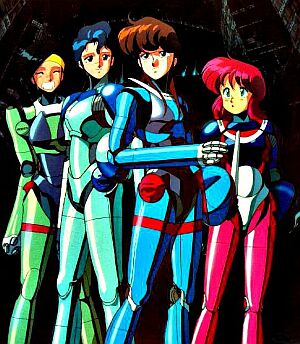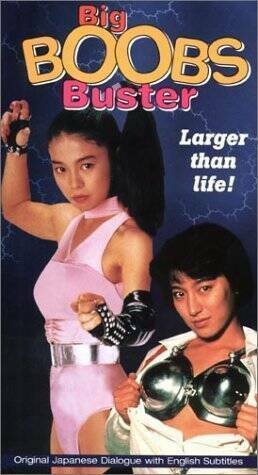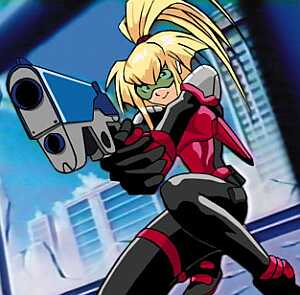★★★
“All men are rapist scum. Now, once again, here are our titties.”
 This resembles an adult version of Cat’s Eye, an 80’s manga which became an anime series, and eventually (1997) also a live-action film. Both feature a trio of ladies with a fondness for tight costumes, who run a cafe by day, while engaging in unusual overtime work. In Cat’s Eye, it was robbery; here, it’s punishing rapists, lechers, etc. in painful, genital-related ways. And, of course, two local policemen patronise the cafe, blithely oblivious to the extra-curricular activities of the trio, who leave a calling-card of a stilletto on their victims, and are known as the “High-Heeled Cats”. [The title above, which it’s generally called, seems to be a Video Search of Miami invention.]
This resembles an adult version of Cat’s Eye, an 80’s manga which became an anime series, and eventually (1997) also a live-action film. Both feature a trio of ladies with a fondness for tight costumes, who run a cafe by day, while engaging in unusual overtime work. In Cat’s Eye, it was robbery; here, it’s punishing rapists, lechers, etc. in painful, genital-related ways. And, of course, two local policemen patronise the cafe, blithely oblivious to the extra-curricular activities of the trio, who leave a calling-card of a stilletto on their victims, and are known as the “High-Heeled Cats”. [The title above, which it’s generally called, seems to be a Video Search of Miami invention.]
It’s strangely schizoid: largely light-hearted, yet including some downright nasty sexual assaults, and the anti-chauvinist message of the heroines is diluted by their dressing, undressing and showering at every opportunity. [I suspect this is the main purpose of the feature, especially since they can’t fight for toffee.] When they cross a Yakuza boss, he uncovers their secret identities and kidnaps one while on a delivery run. It’s up to her friends, aided by the cops, to save the day. After a brisk start, there are few surprises here – subtitles are largely superfluous – though some “vengeances” extracted by the girls are imaginative. This falls some way short of being enough to sustain a feature, and how much you get out of this is possibly linked to your interest in masochism.
Dir: Takashi Kodami
Star: Misuzu Saiki, Manami Morimura, Minori Sonoda (The D-Cats)





 The DVD holds two films, Sasori: Joshuu 701-gô and Sasori: Korosu tenshi, only tangentially connected to Shunya Ito’s Sasori series (the best-known is Female Convict Scorpion: Jailhouse 41) – it also has a heroine who breaks out of jail, and that’s about it. Here, nurse Nami Matsushima (Komatsu) gets ten years for killing the guy who kidnapped and murdered her sister, though just before he dies, he reveals he had an accomplice. In jail, she faces the usual perils (thuggish cellmate, bisexual warden) and meets a girl on death row, framed for a murder committed by a politician – though she killed a prison guard too, so may deserve to die! As execution looms, Nami plans to save her friend. In part two, after her escape, she gets involved with a hitman, and goes back into the prison, in order to rescue his girlfriend.
The DVD holds two films, Sasori: Joshuu 701-gô and Sasori: Korosu tenshi, only tangentially connected to Shunya Ito’s Sasori series (the best-known is Female Convict Scorpion: Jailhouse 41) – it also has a heroine who breaks out of jail, and that’s about it. Here, nurse Nami Matsushima (Komatsu) gets ten years for killing the guy who kidnapped and murdered her sister, though just before he dies, he reveals he had an accomplice. In jail, she faces the usual perils (thuggish cellmate, bisexual warden) and meets a girl on death row, framed for a murder committed by a politician – though she killed a prison guard too, so may deserve to die! As execution looms, Nami plans to save her friend. In part two, after her escape, she gets involved with a hitman, and goes back into the prison, in order to rescue his girlfriend. Despite its title, Prisoner Maria: The Movie has a different set of influences altogether. First up heroine Maria is only a prisoner for a few minutes; the most obvious reference point is Nikita, and it’s not alone.
Despite its title, Prisoner Maria: The Movie has a different set of influences altogether. First up heroine Maria is only a prisoner for a few minutes; the most obvious reference point is Nikita, and it’s not alone.  Based on a manga by Shigeru Tsuchiyama and Shintaro Iba, this is cheerfully shallow stuff, although the occasional sequences of abuse may have more liberal viewers twitching — the depiction of the serial killer at work is unlikely to survive any British release. Aota wears a selection of tight dresses and short skirts, and performs her action scenes creditably enough, though the likes of Michelle Yeoh will not be losing any sleep. In addition, some thought has clearly gone into the story, which is perhaps where it wins out most convincingly over Scorpion’s Revenge.
Based on a manga by Shigeru Tsuchiyama and Shintaro Iba, this is cheerfully shallow stuff, although the occasional sequences of abuse may have more liberal viewers twitching — the depiction of the serial killer at work is unlikely to survive any British release. Aota wears a selection of tight dresses and short skirts, and performs her action scenes creditably enough, though the likes of Michelle Yeoh will not be losing any sleep. In addition, some thought has clearly gone into the story, which is perhaps where it wins out most convincingly over Scorpion’s Revenge.
 The same source comic inspired Lady Snowblood, but plenty of original thought has also been put into this, set in an interesting alternate present, after 500 years of imposed isolation. A band of fighters, the Takemikazuchi, have been thrown out of work and now roam the country, killing for pay. One of their number, Yuki (Shaku), discovers their leader (Shimoda) killed her mother, and after confronting him, leaves. Except the group’s motto seems to be, “No one here gets out alive”… She finds shelter with Takashi (Ito) – except he is part of a rebel group with a similar philosophy, so a quiet, peaceful life is not on the cards for either of them.
The same source comic inspired Lady Snowblood, but plenty of original thought has also been put into this, set in an interesting alternate present, after 500 years of imposed isolation. A band of fighters, the Takemikazuchi, have been thrown out of work and now roam the country, killing for pay. One of their number, Yuki (Shaku), discovers their leader (Shimoda) killed her mother, and after confronting him, leaves. Except the group’s motto seems to be, “No one here gets out alive”… She finds shelter with Takashi (Ito) – except he is part of a rebel group with a similar philosophy, so a quiet, peaceful life is not on the cards for either of them. Any similarities to Buffy are purely coincidental – despite the fact that our heroine Sakuya (Ando), like the blond one, has a soft spot for what she’s supposed to be slaying. Here, she saves the child of her first demon victim, and raises him as her kid brother Taro, despite unnervingly rapid growth and green lump on his head. She takes him on the ultimate mission, travelling to the recently-erupted Mount Fuji, which is the hellmou…er, source of the demons, to face the Spider Queen.
Any similarities to Buffy are purely coincidental – despite the fact that our heroine Sakuya (Ando), like the blond one, has a soft spot for what she’s supposed to be slaying. Here, she saves the child of her first demon victim, and raises him as her kid brother Taro, despite unnervingly rapid growth and green lump on his head. She takes him on the ultimate mission, travelling to the recently-erupted Mount Fuji, which is the hellmou…er, source of the demons, to face the Spider Queen. Don’t believe the running time: listed at 83 minutes on the DVD sleeve, this is actually under 50, a nasty piece of marketing to make you think you’re getting a full-length movie. Not sure whether an extra 25 minutes would help or harm here: there is certainly room for development, but equally, there is an awful lot of slack which seems designed only to show off whizzy digital animation. Saya is a vampire. She’s also a killer, tasked by…well, it’s never quite made clear
Don’t believe the running time: listed at 83 minutes on the DVD sleeve, this is actually under 50, a nasty piece of marketing to make you think you’re getting a full-length movie. Not sure whether an extra 25 minutes would help or harm here: there is certainly room for development, but equally, there is an awful lot of slack which seems designed only to show off whizzy digital animation. Saya is a vampire. She’s also a killer, tasked by…well, it’s never quite made clear  Worthy of note as one of the first pieces of anime made available to an English-speaking audience, (not long after its original 1985 Japanese release), BGC is set in 2032, when Tokyo has been rebuilt, post-earthquake. The Genom corporation are fiddling with Boomers, biomechanical robots of immense strength but with a nasty tendency to run amok. Standing guard are a mysterious team, the Knight Sabers, with their own technological strengths, who alternate between merc work and more altruistic concerns.
Worthy of note as one of the first pieces of anime made available to an English-speaking audience, (not long after its original 1985 Japanese release), BGC is set in 2032, when Tokyo has been rebuilt, post-earthquake. The Genom corporation are fiddling with Boomers, biomechanical robots of immense strength but with a nasty tendency to run amok. Standing guard are a mysterious team, the Knight Sabers, with their own technological strengths, who alternate between merc work and more altruistic concerns. As you can probably surmise from the title, this is most emphatically
As you can probably surmise from the title, this is most emphatically  You know where you stand with this film inside five minutes, from the moment policewoman heroine Mika Hino (Shiratori) is made to strip off by bad guys hunting for a key – which she naturally is keeping in her lingerie. Mind you, this pales in comparison with where partner Rin Kakura (Kuribayashi) hides her gun… The problem with this tape is that such intimate details are far more interesting than the plot, a tired and severely uninteresting search for a master counterfeiter.
You know where you stand with this film inside five minutes, from the moment policewoman heroine Mika Hino (Shiratori) is made to strip off by bad guys hunting for a key – which she naturally is keeping in her lingerie. Mind you, this pales in comparison with where partner Rin Kakura (Kuribayashi) hides her gun… The problem with this tape is that such intimate details are far more interesting than the plot, a tired and severely uninteresting search for a master counterfeiter. This teeters infuriatingly close to greatness, but eventually succumbs to mediocrity because of a tendency to juvenile smuttiness, that fatally weakens what is, at heart, an intriguing story and setting. The Warriors are a special police group – mostly female, with one token (lecherous) man – sent in to sort out nasty cases. The main thread in the four episodes here, is a virtual drug which can turn the consumer into a mind-controlled killer – or, presumably, anything else desired.
This teeters infuriatingly close to greatness, but eventually succumbs to mediocrity because of a tendency to juvenile smuttiness, that fatally weakens what is, at heart, an intriguing story and setting. The Warriors are a special police group – mostly female, with one token (lecherous) man – sent in to sort out nasty cases. The main thread in the four episodes here, is a virtual drug which can turn the consumer into a mind-controlled killer – or, presumably, anything else desired.